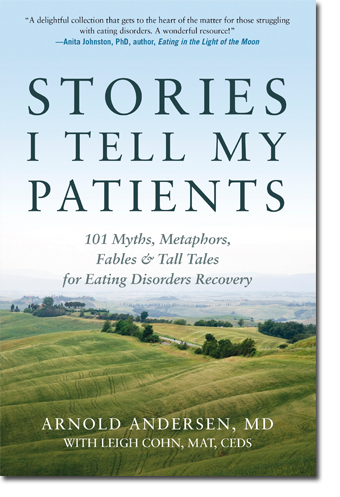
Stories I Tell My Patients
101 Myths, Metaphors, Fables & Tall Tales for Eating Disorders Recovery
by Arnold Andersen, MD and Leigh Cohn, M.A.T.
101
Jeanette’s Feast
all eating disorders, recovery tool, family dynamics, quality of life
Jeanette thought her anorexia was the secret to a happy life. It gave her a sense of security, identity, and control. Having moved to the Midwest from France as a small child, she dreaded the major holidays, when her family celebrated with an abundance of the kinds of tasty foods she resisted. For July 4th, there’d be no hot dogs, hamburgers, or German potato salad for her; no chocolate cake with an American flag on top, no matter how yummy it looked. Her no-fat cottage cheese was more than plenty. Thank you very much. Thanksgiving was the worst, what an indulgence—for her to avoid.
Jeanette had grown taller, but by age 15 she still had not developed regular monthly cycles. Her mother took her to the pediatrician to find out what was going on, and after an assessment, the doctor explained, “Well, Jeanette, you have anorexia nervosa. It comes from an overvaluation of thinness. I wouldn’t be surprised if you think you are a little overweight and want to take off some pounds.”
“You must be reading my mind,” she replied, “but I like being thinner.”
“Jeanette, I’d like you to see one of my colleagues, Dr. Hasan, who is a very good psychologist. She’s warm and likes teens.”
So, grudgingly at first, but eventually with more insight and enthusiasm, Jeanette bonded with Dr. Hasan and came to see how dreadfully thin she was. After about six months, her recovery had progressed brilliantly. She had just about reached a healthy weight, and began to see Dr. Hasan every other week, and a year later, once a month. “I can’t believe I didn’t see what this self-starvation was all about,” she admitted. “Now, I like myself; and, there’s something important I want to do for my family.”
For the French Feast of the 3 Kings, also called Twelfth Night, she planned a very special desert: a galette des Rois, a rich cake traditionally served only on that holiday. It contained lots of almond paste, chocolate, and fruits; and, hidden inside was a small crown that would be prized by the lucky person who found it in their slice. Her family rarely celebrated this day in the U.S., so they didn’t suspect a thing. Jeanette secretly assembled the ingredients at a friend’s house, even the little symbols that go on top of the cake, as well as the crown for inside.
She also prepared a whole feast meal to serve them: scallops in cream for the first course, followed by a lean filet mignon with a mushroom and butter sauce, tiny French green beans, and escalloped potatoes with cheese on top. A meal that would have terrified her to eat in the past, she was delighted to serve and enjoy. Her surprised family was blown away, but more was to come. After the salad course (always served after the entrée), she turned the lights down. Then, while humming a French tune, she carried in the galette des Rois, with candles on top—the kind you can’t blow out (the French might not approve but who cares)—and placed it in the center of the table. She didn’t notice the tears of joy in her mother’s eyes.
“My loving family,” she began, “you have been so supportive through my ordeal with anorexia. Thank you mille fois (a thousand times). I’m over it for good! I wanted to mark my recovery with you on this special feast day, in our French tradition. From now on, the Feast of the 3 Kings will also be ‘Jeanette’s Feast Day,’ and count on me to make the cake. I love you all.” As they delighted in the delicious galette, no one was surprised when Jeanette bit into the tiny crown.
Comment:
What a misery it is for patients with anorexia nervosa to attend festive meals—not binges, but good, old-fashioned feasts—whether American, French, or from any tradition. Usually a person with anorexia nervosa avoids the event entirely, or cooks up a storm and then doesn’t eat. What a triumph of the recovery process to be able to partake with glee. You might want to see the classic film, Babette’s Feast, about a poor French woman who emigrates to Denmark (subtitles) and finally finds the money to throw a feast for the family that has sheltered her. No one is shot, no galactic invaders. But once you get used to the measured pace, and the great feast is finally served, the viewer practically becomes a participant with the reserved community who discover what a feast is truly about—a celebration of love and sharing.